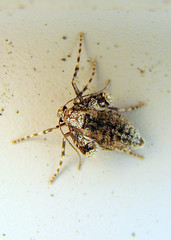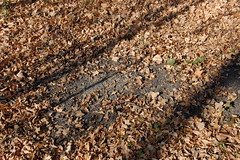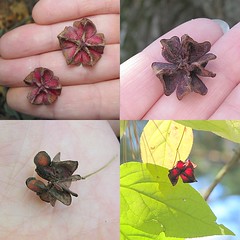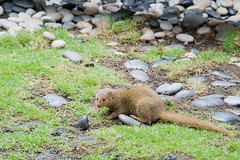Reuters Africa has a report about invasive species plaguing the island of Mauritius. From an ecological standpoint, Mauritius may be most famous as the home of the famously extinct dodo bird. Now the remaining native fauna of the island, already threatened by established populations of rats and monkeys, are seeing increased predation by new introductions including the giant Malagasy day gecko (Phelsuma madagascariensis) and the Indian musk shrew (Suncus murinus). Native flora is also being impacted, by herbivores as well as through plant introductions such as the Chinese guava (Psidium cattleianum) and the climbing vine known as hiptage (Hiptage benghalensis).
Friday, November 30, 2007
Wednesday, November 28, 2007
2008 Calendars Are Here!
The Invasive Species Weblog 2008 Wall Calendar is now available for purchase at Cafepress:
The calendar features more than a dozen invasive plants and animals, each depicted in an 11 x 8.5 inch full-color photo. Among this year's selections are Black Swallow-wort, Mute Swan, and Yellow Starthistle. If you click through you can see a preview of all twelve months.
The ISW store is also chock full of many more gifts for your favorite weed geek. All (meager) earnings received go to charity or back to ISW readers as contest prizes.
Tuesday, November 27, 2007
Motherland
It's that time of year again! A lot of people have been stopping in at the ISW lately, following Google searches for some variation of the phrase "European winter moth." Sure enough, there are moths out and about in Massachusetts, though it is tricky to tell apart the three winter flyers we get: the European winter moth (Operophtera brumata) and the native Bruce spanworm moth (Operophtera bruceata) and fall cankerworm moth (Alsophila pometaria). For your convenience, I present the following links:
- The UMass Extension web page "Identifying and Managing the Life Stages of Winter Moth" - in my opinion the best reference available on the web.
- Previous ISW posts about the winter moths.
Monday, November 26, 2007
A Little Less Didymo
Diligent ISW readers may remember this post from October about the discovery of the algae known as didymo (Didymosphena geminata, also known as "rock snot") on the North Island of New Zealand. Tests done by Biosecurity New Zealand indicated the presence of dead cells of the algae in several North Island Rivers, with all signs pointing to the arrival of didymo after being known on the South Island for several years.
As a commenter noted, no live cells were found in the North Island samples, and now Scoop news is reporting that the actual source of the dead cells was...contaminated sampling containers. Lids used to seal the containers were sent off in sampling equipment with microscopic amounts of dead didymo cells left over from lab testing. The lab says they have protocols in place to prevent the transfer of any live plant matter, and it looks like they will be adding steps to prevent the transfer of dead organic material as well.
Tip of the virtual hat to the Protect Your Waters website for posting a link to this story.
Sunday, November 25, 2007
Weekend Photoblogging
Thanks to esagor for sharing this photo under a Creative Commons license. Do click over to his photo page to read more about the negative impacts of non-native earthworms.
Friday, November 23, 2007
Christmas in Hawaii?
A whole bunch of Christmas trees headed for Hawaii earlier this week were quarantined after inspectors discovered at least two different wasp species in the shipping containers. USA Today is reporting that the containers, sent from Oregon, contained two German yellow jacket wasps (Vespula germanica), including one live queen, and three other live wasps that have yet to be identified. The German wasps, which have never been recorded in Hawaii, were of particular concern due to their propensity for living in suburban and urban environments.
One of the contaminated containers was sent back to the company it came from, and the rest, according to this article at the Honolulu Star Bulletin, were vigorously inspected by officials from the Hawaiian Department of Agriculture's Inspection and Compliance Section. Hawaiians with Christmas tree cravings need not fear however, since over one hundred of the containers, each carrying 300 trees, did pass inspection, and more are on the way.
Thursday, November 22, 2007
Gobbles!
Bits of turkey from an invasive species perspective:
- The Windsor Star is reporting that the emerald ash borer (Agrilus planipennis) has been discovered in Turkey Point, the furthest east the beetle has even been seen in the province of Ontario, Canada.
- Turkeyfish (Pterois volitans, also known as lionfish) are establishing off the coast of Georgia. LiveScience has more, plus a pretty picture.
- invasive.org has got the scoop on turkey berry (Solanum torvum), an invasive plant from the West Indies that has spread into tropical areas around the globe.
- Get even more turkeyfish over at the cephalopodcast blog, where Jason is serving up some tasty Turkey Day morsels.
Wednesday, November 21, 2007
Hoofin' It
Sounds like hooved beasts are causing trouble in the invasive species world this week. Newswise recently posted this report about new research suggesting that horses are in part responsible for spreading non-native plants along trails in Colorado. Scientists picked through road apples and discovered that the horses were carrying a lot of alien seed in their feces. While there was no particular species that the horses are being blamed for spreading, the research does remind us that horses are potential vectors of invasive plants and should not be overlooked. Kudos to the journal Rangeland Ecology & Management for making the full paper available online for free.
Over in Wisconsin, deer hunting season is about to start, and this year hunters will be helping collect data on invasive plants. Every deer brought in to the Department of Natural Resources for registration will have its hooves checked for invasive plants. Students from Luther College in Iowa will be assisting the Wisconsin DNR in collecting the data. Here's hoping we hear back from them on their findings - they say this is the first study of its kind for white-tail deer (Odocoileus virginianus, native to the US), and the results should be interesting. WKBT.com has the full story.
Thanks to budak for sending in a link to the horse tale. If you have an interesting invasive species story that you would like to share, send it in by clicking on the "Suggest a Post" link in the top right corner.
Tuesday, November 20, 2007
Snakes Eyed
The Army Times is reporting that a group of political leaders from the Pacific Island region known as Micronesia have joined together to ask US Secretary of Defense Robert Gates to make sure that the US military doesn't allow the invasive brown tree snake (Boiga irregularis) to spread from Guam. The officials want the US to set an official policy that guarantees sufficient prevention measures are in place. Included in these measures: funding for new invasive species detection tools, and a lofty goal of completely eradicating the brown tree snake from Guam.
Monday, November 19, 2007
How Do I Loathe Thee?
In case you missed Friday's post, there is probably still time for you to get your two cents in to NPR about what you think are "The 5 most loathed invasive species in the world."
Sunday, November 18, 2007
Weekend Blog Blogging
The past week in invasive species posts, from elsewhere in the blogosphere:
- In the same vein as this request from NPR's John Nielsen, Environmental graffiti lists "The 5 Worst Invasive Species in the World."
- From the appletree blog comes the sad story of a bird-watching aficionado facing criminal charges for killing a feral cat in Texas.
- The RoguePundit posts about feral horses in Australia.
Weekend Photoblogging
The jury is not yet in on whether this is E. planipes or E. sachalinensis. The fruits were odd in that the number of locules (chambers) they contained varied, even on the same plant, between four and five.
Friday, November 16, 2007
Fear And Self-Loathing On NPR
Want a chance to be heard on NPR? Science reporter John Nielsen is prepping a story for next week's news on the "five most loathed invasive species in the world." There are only two rules to follow here: 1) Be specific and 2) No diseases. I'd like to add a 3) No fair saying "humans" - we're too easy a target.
What would you put on the list? If you want to give John a piece of your mind, drop him a line at 202-513-2781 or email him at jnielsen AT npr DOT org. He's especially hoping to hear from scientists, but everyone is welcome to participate. If you're too shy to share with public radio, let's get a discussion started in the comments!
Here is my list, which was awfully hard to make, because I love all invasive species equally ;-). In no particular order:
- Didymo (Didymosphenia geminata) - The spread of this freshwater aquatic algae is near impossible to detect or control. It's all over New Zealand and was recently discovered in the Northeastern USA. I cannot think of an invader that would make resource managers feel more helpless or frustrated, and anglers are certainly peeved as well.
- Northern snakehead (Channa argus) - Hated widely because it is so charismatic, rather than for its impact. They've made two movies about this fish already!
- Fire ants (Solenopsis invicta) - No one likes biting insects, especially ones that travel in packs.
- Mute swan (Cygnus olor) - Only because the amount that this species is hated by the people charged with managing them and people concerned with their environmental impact is directly proportional to the amount that this species is loved by animal rights activists and those captivated by their aesthetic qualities.
- The abominable feral kudzu hydrilla pig-carp. Okay, so this last one is a cop-out :-).
Thursday, November 15, 2007
Glaring At The Sea
The Balkan Investigative Reporting Network has an excellent article summarizing the current problems plaguing the Adriatic Sea following an incursion of the invasive alga Caulerpa racemosa. It is now recognized that Caulerpa, first discovered in 2000, is likely a permanent part of the Adriatic, however there has yet to be any plan put into place to control its movement. While a few countries bordering the Adriatic, including France, Croatia and Montenegro, have allocated low levels of funding towards Caulerpa control, the article notes that a coordinated, regional effort would be most effective at preventing the further spread of the seaweed. One roadblock to such an effort is the bad political blood that remains between some countries following the wars that occurred in the Balkans during the 1990s.
Wednesday, November 14, 2007
The Emperor's New Fish
The International Herald Tribune is reporting that the Emperor of Japan is expressing much regret over his decision to accept a gift of live bluegill (Lepomis macrochirus) from the United States. He brought the fish home in 1960 and, with the hope that he could cultivate them as a food fish, gave them to Japan's Fisheries Agency. Researchers there then bred the fish and released many of them into Lake Biwa. Unfortunately, bluegill numbers eventually got out of hand, and the native fauna of the lake has since declined. With peak populations of the non-native fish topping 2 million in 2002, Japan has been forced to spend millions of dollars removing bluegill from the lake.
Tip of the virtual hat to the annotated budak for sending in a link to this story.
Tuesday, November 13, 2007
Going Bo Bo
The Molokai Times reports that last week's meeting of the Maui Invasive Species Committee revealed several interesting new invaders on the Hawaiian islands of Maui and Molokai. Perhaps most intriguing is one botanist's observation that the bo tree (Ficus religiosa, also known as the sacred fig), an Asian import often planted as a religious symbol, is on the move. Once thought to be able to spread only by cuttings, the bo tree is apparently now able to reproduce by seed, following the recent arrival of a wasp that can act as a pollinator. Surveys of Molokai for wild bo trees are in progress, along with plans to prevent the trees from producing seeds. The committee is also asking anyone on Maui or Molokai that knows the location of a bo tree to contact them.
Bonus points to the Molokai Times for using the bo tree's scientific name.
Monday, November 12, 2007
Turtle Power!
Andrew B. sends in this story from the Manawatu Standard about the red-eared slider turtle (Chrysemys scripta elegans) in New Zealand. Sliders are North American species, and are often kept as pets or used as food in other countries. A wild slider was recently discovered hanging out by Kawau Stream and later captured by the New Zealand Department of Conservation. Apparently they've taken a liking to the turtle, who is now named Donatello. Wildlife officials aren't sure if the turtle is a recent escape, but New Zealand is currently thought to have too cold a climate for red-eared sliders to overwinter there.
Sunday, November 11, 2007
Weekend Blog Blogging
The past week in invasive species posts, from elsewhere in the blogosphere:
- Words & Pictures has an interesting post about American skunks discovered in the wild in the UK. I would think they'd be pretty low on the pet totem pole, but apparently not.
- Other bloggers had some fun with this ISW post about praying as a control method for invasive species. At bogalusa, you can read a great little poem. Drew at Drew's Brave New World suggests a new powerful acronym: WWKD (What Would Kudzu Do?). Someone put that on a bumper sticker, stat! :-)
- Fisher at the Luxury Gardens blog is a garden designer, but the questions he gets most frequently are about how to get rid of invasive plants.
- That Fish Blog has a post about lionfish, which they sell at That Fish Place but don't want you to ever release into the wild.
Friday, November 09, 2007
Rhino Blasty
Guam is in the midst of fighting off an invasion of coconut rhinoceros beetles (Oryctes rhinoceros) that are attacking the island's palm trees. The beetles were first spotted this past September, and a quarantine has been in effect since October in an attempt to keep the beetles from spreading. The Pacific Daily News is reporting that one local resort, the Pacific Island Club, is extremely concerned that damage to their palm trees translates to damage to Guam's tourism industry. They have taken the initiative and set their own pheremone traps to capture the beetles. The Guam Department of Agriculture has also set out over 100 traps and together the two groups have caught almost 20 beetles so far.
Thursday, November 08, 2007
Click It Or Tick It!
There is still time to vote for the Invasive Species Weblog in the Best Science Blog category of the 2007 Weblog Awards. Go on, click it, you know you want to!
Voting ended with the ISW in 5th place...and then somehow two hours later the ISW was in 6th place. Either way, it was good just to be a finalist, and to see all the new visitors that stopped by over the past week!
Wednesday, November 07, 2007
Blister Blues
The Tahoe Daily Tribune is reporting that white pine blister rust (Cronartium ribicola) is on the move in the Tahoe Basin, the area surrounding Lake Tahoe in California and Nevada. The rust fungus, an introduction from Central Asia, attacks sugar pine, Western white pine, whitebark pine (commonly referred to as the "five-needle" pines), and many species of currants (Ribes spp.) as well. Once infected, the trees are weakened and can die from secondary infections, insect infestations, or from the rust fungus alone.
Given the difficulty of fighting a fungal invader, which can easily spread to new trees through tiny, wind-blown spores, scientists are instead focusing on the discovery of sugar pines that are resistant to the rust. A breeding program currently in progress aims to grow as many resistant seedlings as possible so that they can be planted throughout Tahoe Basin.
If you are curious about the origin and global spread of white pine blister rust, this PowerPoint presentation from Kim Hummer will provide you with all the details.
Tuesday, November 06, 2007
Worm Woods
Holy Jumping Wormies, Batman! Sounds like Georgia has got some serious problems with Asian earthworms. Affectionately known as "Alabama jumpers" (Amynthas agrestis), these worms are known for their ability to jump right out of a bait cup. They are also known by scientists for their aggressive behavior, raising concerns that they could be having an impact on native earthworm species. Now the worms have recently been observed moving into forested areas in the Smoky Mountains, as evidenced by patches of the forest floor now completely devoid of any leaf litter. The Athens Banner-Herald has the full story, or you can read a paper on the subject here. Bonus points to the Banner-Herald for using the worm's scientific name.
Monday, November 05, 2007
Botox For The Birds
A story from the AP is suggesting that the recent swarm of bird deaths in Michigan are the indirect result of the proliferation of invasive species in the Great Lakes. The birds are washing ashore at Lake Michigan by the dozen, with the cause of death determined to be avian botulism (type "E"), one of several episodes to occur over the past few years. The botulism itself is not considered invasive, but scientists are speculating that it is getting to the birds through a food chain of invaders: Zebra and quagga mussels (Dreissena polymorpha and D. rostriformis bugensis) containing the bacteria that causes botulism (Clostridium botulinum) are either consumed by birds or consumed by invasive round gobies (Neogobius melanostomus), which are then consumed by birds.
I am not sure if invasive species are specifically to blame here, or if it is just that the invaders are so numerous that they now make up a significant portion of the diet of birds that frequent the Great Lakes. Are zebra and quagga mussels the only ones that can filter botulinum bacteria? Do round gobies harbor more of the bacteria than native fish? The AP article glosses over the surface of the full story, so I did some investigating and found the following hypotheses, summarized from this well-written article from Michigan Sea Grant and this one from Wisconsin Sea Grant:
- Invasive mussels create a type of habitat that is more favorable for the growth of Clostridium botulinum.
- Zebra and/or quagga mussels filter at a much faster rate than native mussel species, allowing the toxins and pathogens that they filter out to build up to a greater degree than similar-sized native species.
- The filtering power of these invasive mussels clears the water, allowing the algae Cladophora to grow. When this algae reaches sufficient numbers and then dies, the resulting anaerobic water conditions encourage the growth of Clostridium botulinum.
It is important to note that none of these hypotheses have yet been proven to be an underlying cause of avian botulism. Research continues in both the US and Canada in order that we might one day understand the cycle of bird deaths and stop it from repeating. Until then, the invasive mussels may seem the most obvious target of blame but it could turn out that the situation is much more complicated.
Sunday, November 04, 2007
Weekend Blog Blogging
The past week in invasive species posts, from elsewhere in the blogosphere:
- Sifolinia takes a break from ant blogging to pick up some Asian lady beetles, and ponders whether it is already a lost cause.
- Even more about the light brown apple moth, this time from 0tt's livejournal.
- Walking is Transportation posts about a new path that's as good for walkers as it is bad for invaders.
Saturday, November 03, 2007
Weekend Photoblogging
The mongoose (Herpestes javanicus) was intentionally introduced to the Hawaiian Islands back in the mid 1800s as a biological control for rats, a job it failed at miserably.
Bonus points to Stv. for sharing this photo under a Creative Commons license!
Friday, November 02, 2007
Words Of Pray
There's an interesting little piece in today's Christian Science Monitor about an invasive species control method that I must admit I have never considered: prayer. The author of the article notes that global efforts to manage invasive species are stalled by politics and by social issues, and goes on to suggest praying as something that can be done right now and that could inspire folks to come up with potential solutions and lead to greater cooperation. Sort of like brainstorming with God I guess. The article comes complete with a parable about a farmer with an enemy who intentionally introduces a weed into his wheat field.
I have to admit, the idea of people praying for a solution to invasive species problems intrigues me. I would have guessed this issue would be much further down on the prayer totem pole, somewhere below praying for an end to global warming.
P.S. - I know you Pharyngula pholks are out there. Be kind, rewind.
Thursday, November 01, 2007
One Lake At A Time
In an attempt to slow the spread of VHS (Viral Hemorrhagic Septicemia) in their state, the Wisconsin Department of Natural Resources has enacted emergency regulations stating that anyone exiting a body of water must now make sure to drain his/her boat and fishing equipment. VHS, first discovered in the Great Lakes Region in 2005, infects mostly salmonid types of fishes (salmon, trout, etc.) and remains viable in water for up to two weeks, meaning that it could be spread easily by angling activities. Perhaps more frustrating for anglers is the additional rule that any fish taken away from a body of water in Wisconsin must be dead, even bait fish. As a fishing guide says in this story from WJFW, that could be a pain for anyone wanting to visit multiple bodies of water in a single day.
You Can't Win If You Don't Play
The Invasive Species Weblog has made it to the finalist round of the Best Science Blog category of the 2007 weblog awards. It is an honor just to be nominated, especially given that there's not a chance the ISW will be victorious in a battle that includes the likes of Pharyngula and SciGuy. But hey, if you're here via the awards pages, thanks for stopping by, enjoy your stay, and I hope you learn something while you're here.
Update: The polls are now open. Vote here!




